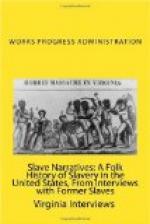“One day a soldier stop me an says, ‘Sister, where do you live?’ I tole him, den he says, ‘I’m hungry.’ So I went an got him sompin to eat.
“One time I was to be sold de next day, but de missy tole the man who cried the block not to sell me, but deh sold my mother and I didn’t see her after dat till just befoh de war ovah.
“All dat de slaves got after de war was loaned dem and dey had to work mighty hard to pay for dem. I saw a lot of poor people cut off from votin and dey off right now, I guess. I doan like it dat de woman vote. A woman ain’t got no right votin, nowhow.
“Most of de slaves get pensions and are taken care of by their chillun.”
“Ah doan know about de generation today, just suit yourself bout dat.”
Julia Williams resides at 150 Kyle St., Wadsworth, Ohio.
Miriam Logan
Lebanon, Ohio
July 8th
Warren County, District 2
Story of REVEREND WILLIAMS, Aged 76,
Colored Methodist Minister,
Born Greenbriar County, West Virginia (Born 1859)
“I was born on the estate of Miss Frances Cree, my mother’s mistress. She had set my grandmother Delilah free with her sixteen children, so my mother was free when I was born, but my father was not.
“My father was butler to General Davis, nephew of Jefferson Davis. General Davis was wounded in the Civil War and came home to die. My father, Allen Williams was not free until the Emancipation.”
“Grandmother Delilah belonged to Dr. Cree. Upon his death and the division of his estate, his maiden daughter came into possession of my grandmother, you understand. Miss Frances nor her brother Mr. Cam. ever married. Miss Frances was very religious, a Methodist, and she believed Grandmother Delilah should be free, and that we colored children should have schooling.”
“Yes ma’m, we colored people had a church down there in West Virginia, and grandmother Delilah had a family Bible of her own. She had fourteen boys and two girls. My mother had sixteen children, two boys, fourteen girls. Of them—mother’s children, you understand,—there were seven teachers and two ministers; all were educated—thanks to Miss Frances and to Miss Sands of Gallipolice. Mother lived to be ninety-seven years old. No, she was not a cook.”
“In the south, you understand—there is the COLORED M.E. CHURCH, and the AFRICAN M.E. CHURCH, and the SOUTHERN METHODIST, and METHODIST EPISCOPAL CHURCHES of the white people. They say there will be UNION METHODIST of both white and colored people, but I don’t believe there will be, for there is a great difference in beliefs, even today. SOUTHERN METHODIST do believe, do believe in slavery; while the Methodist to which Miss Frances Cree belonged did not believe in slavery. The Davis family, (one of the finest) did believe in slavery and they were good southern Methodist. Mr. Cam., Miss Frances brother was not so opposed to slavery as was Miss Frances. Miss Frances willed us to the care of her good Methodist friend Miss Eliza Sands of Ohio.”




